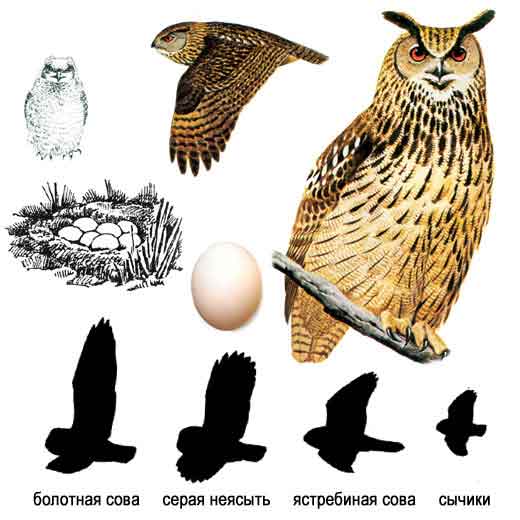
© -
lubomir hlasek
Size: Length: 58-71cm
(22.8-28")
Weight: Female 2280-4200g (80.4-158oz) Male 1620-3000g (57.1-105.8oz)
Average Wing Length (one wing only): Female 47.8cm (18.8")
Male 44.8cm (17.6")
Active mainly at dusk
to dawn. Flight is noiseless, whith soft wingbeats interrupted by
gliding
when flying over long distance. Will sometimes soar.
Voice: A deep, monotonous
"oohu-oohu-oohu".
The female's call is slightly higher than the male's.
When threatened, they may bark and growl.

http://www.owlpages.com
Eagle Owls occupy
a variety of habitats, from coniferous forests to warm deserts.
Rocky landscapes are often favoured.
Adequate food supply and nesting sites seem to be the most important
prerequisites.
Distribution: North
Africa, Europe, Asia, Middle East.

©
www.ecosystema.ru/
Eagle Owls have various
hunting techniques, and will take prey on the ground or in full
flight.
They may hunt in forests, but prefer open spaces.
Eagle Owls will eat almost anything the moves - from beetles to
roe deer fawns.
The major part of their diet consists of mammals (Voles, rats, mice,
foxes, hares etc...),
but birds of all kinds are also taken, including crows, ducks, grouse,
seabirds,
and even other birds of prey (including other owls).
In some coastal areas, they have been known to feed mainly on ducks
and seabirds.
Other prey taken include snakes, lizards, frogs, fish, and crabs.
The Male and Female
duet during courtship, the Male advertising potential breeding sites
by scratching a shallow depression at the site and emitting staccato
notes and clucking sounds. Favoured nest sites are sheltered cliff
ledges, crevices between rocks and cave entrances in cliffs.
They will also use abandoned nests of other large birds.
If no such sites are available, they may nest on the ground between
rocks,
under fallen trunks, under a bush, or even at the base of a tree
trunk.
No nesting material is added.
Very often pairs for life. They are territorial, but territories
of neighbouring pairs may partly overlap.

©
www.ecosystema.ru/
Laying generally begins
in late winter, sometimes later.
One clutch per year of 1-4 white eggs are laid, measuring 56-73mm
x 44.2- 53mm (2.2- 2.9" x 1.7- 2.1")
and weighing 75- 80g (2.6- 2.8oz).
They are normally laid at 3 days intervals and are incubated by
the female alone,
starting from the first egg, for 31-36 days.
During this time, she is fed at the nest by her mate.

©
www.ecosystema.ru/
Once hatched, the young are brooded for about 2 weeks;
the female stays with them at the nest for 4-5 weeks.
For the first 2-3 weeks the male brings food to the nest or deposits
it nearby,
and the female feeds small pieces the young.
At 3 weeks the chicks start to feed themselves and begin to swallow
smaller items whole.
At 5 weeks the young walk around the nesting area, and at 52 days
are able to fly a few metres.
They may leave ground nests as early as 22-25 days old,
while elevated nests are left at an age of 5-7 weeks.

© -
josef hlasek
They become independent
between September and November in Europe,
and leave the parents' territory (or are driven out by them).
At this time the male begins to sing again and inspect potential
future nesting sites.
Young reach maturity in the following year, but normally breed when
2-3 years old.
Eurasian Eagle Owls
may live more than 60 years in captivity.
In the wild, about 20 years may be the maximum.
They have no real natural enemies; electrocution, collision with
traffic,
and shooting are the main causes of death.

Eurasian
eagle-owl - overview
BBC Natural History Unit
http://www.arkive.org

©
www.ecosystema.ru/
All
text above: ©
http://www.owlpages.com
500
other birds - click here















